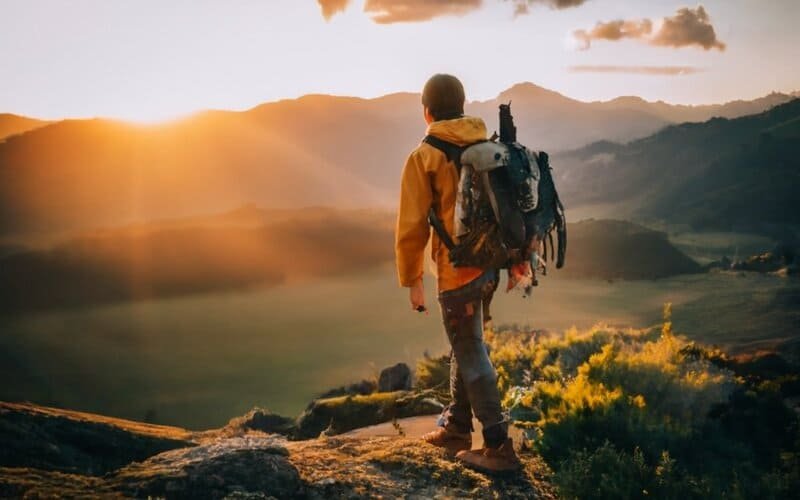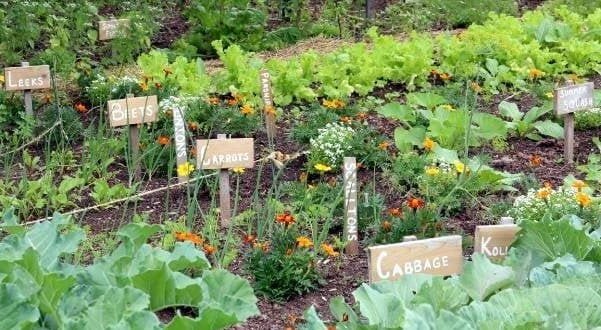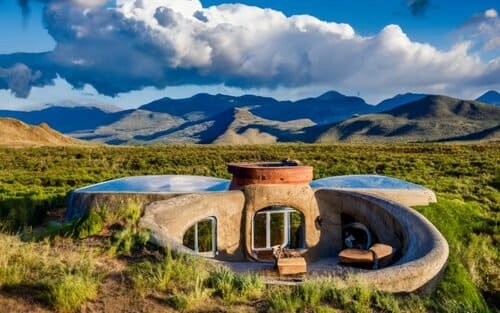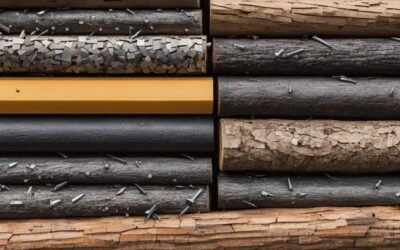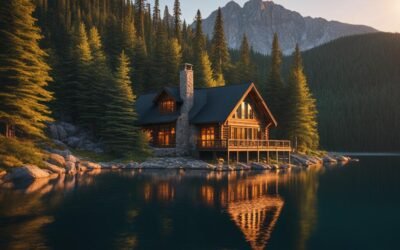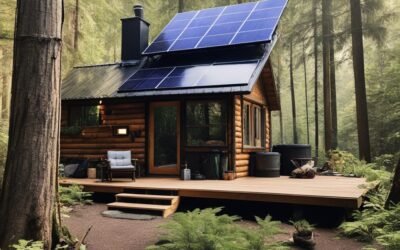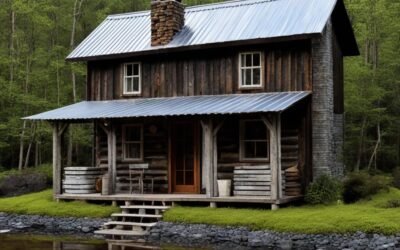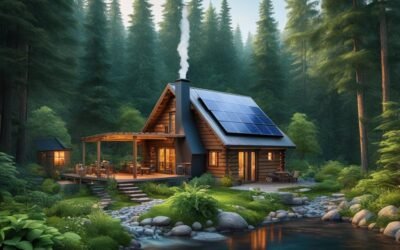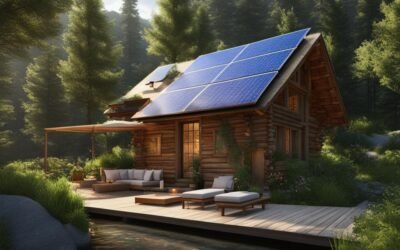There’s something profoundly liberating about the concept of off-grid living. It’s a journey I’ve embarked on to reshape my life through a sustainable lifestyle that fosters self-sufficiency and a reduced ecological footprint. Imagine breaking free from the grid’s chains, where I’m no longer just another consumer but a proactive creator of my life, wielding tools of resilience and self-reliance.
My passion for learning how to live self sufficient off the grid has led me to explore various self-sufficiency tips, from harvesting rainwater to mastering the art of permaculture. These skills haven’t just given me a sense of independence; they’ve also cultivated an intimate connection with the environment and a stronger community spirit. Join me as I navigate the verdant path towards a sustainable future that many dream of but few dare to tread.
Key Takeaways
- Embracing off-grid living means cultivating a life of reduced dependence on traditional systems.
- Achieving a sustainable lifestyle off-grid encompasses balancing ecological awareness with practical self-sufficiency.
- Off-grid living can contribute to significant personal growth and stronger community connections.
- Self-sufficiency skills are pivotal in transforming passive consumers into resourceful creators.
- Living off the land invites a unique freedom that reconnects individuals to their family, nature, and innate resilience.
- Adapting to off-grid challenges can lead to a deeper appreciation for life’s essentials and a more harmonious existence.
Embracing a Sustainable Lifestyle Through Off-Grid Living
As I delve into the world of off-grid living, I’ve realized it’s not just about disconnecting from the grid; it’s about reconnecting with the planet. Adopting a sustainable living practice requires a shift in mindset, where every choice aligns with a philosophy of embracing sustainability. This transformation encompasses everything from energy consumption to waste management, illustrating that the pursuit of a self-reliant lifestyle is both a necessity and an art form.
For many, including myself, the journey to sustainability began with a passionate yearning for independence and accountability. Crafting a homesteading guide has become more than compiling tips – it’s about chronicling life-changing behaviors. Below is a snapshot of how I’ve integrated key practices into my daily life to foster an eco-friendly existence:
- Reducing waste by composting and recycling, diligently avoiding single-use plastics
- Growing a vegetable garden and using permaculture principles to enrich the soil and ecosystem
- Harvesting rainwater and utilizing greywater systems for irrigation and sanitation needs
- Installing solar panels to harness clean energy, thus reducing our carbon footprint
- Building with reclaimed and natural materials, creating a home that breathes with the earth
- Participating in local swaps and sharing resources with my community to reduce consumption
Each of these practices is a thread in the larger tapestry of sustainable living. The key to a harmonious off-grid lifestyle lies not just in self-sufficiency but in the sustainable integration within our natural surroundings and communities.
“The earth provides enough to satisfy every man’s needs, but not every man’s greed.” – Mahatma Gandhi
Indeed, my shift towards a self-reliant lifestyle has been as much about nurturing my relationship with the land as it has been about minimizing my reliance on mainstream supply chains. It’s a continuous cycle of learning, adapting, and thriving that reminds us daily that our actions matter, not just for ourselves, but for the world we all share.
Establishing Your Off-Grid Homestead: First Steps
 Embarking on an off-grid lifestyle is an exhilarating move towards self-sufficiency and eco-conscious living. One of the pivotal moments in this journey is setting up a homestead that aligns with one’s aspirations for a sustainable life. Let’s explore the foundational elements that will help you create your haven in the wilderness.
Embarking on an off-grid lifestyle is an exhilarating move towards self-sufficiency and eco-conscious living. One of the pivotal moments in this journey is setting up a homestead that aligns with one’s aspirations for a sustainable life. Let’s explore the foundational elements that will help you create your haven in the wilderness.
Finding and Developing Free or Low-Cost Land
My initial step in establishing an off-grid homestead was focused on finding free land or securing a low-cost homesteading opportunity. It may sound daunting, but with thorough research and determination, I discovered that some rural communities offer land to those willing to invest the effort to develop it. These plots, often nestled away from the hustle and bustle of city life, awaited pioneers ready to utilize them to their full potential. From negotiating with local authorities to understanding zoning laws, it’s imperative to ensure your chosen land can support your vision for a self-sufficient food supply and sustainable living practices.
Designing Eco-Friendly Dwellings for Efficiency
With a plot of land secured, I turned my attention to eco-friendly construction methods and following the principles of a sustainable house design. Opting for a compact living space like a cabin or a tiny house proved to be a strategic decision. The use of passive heating and cooling systems, sourced from natural materials local to the area, became the cornerstone of my efficient home. The intelligent design that made the most of the sun’s path and thorough insulation ensured year-round comfort, reducing dependency on energy-consuming heating and cooling solutions.
Planting the Seeds: Creating a Sustainable Food Source
I understood early on that no homestead is complete without a robust plan for nourishment. Integrating organic farming methods into your homestead is not only an investment in health but also in your independence. Establishing a sustainable farm that provided me with a self-sufficient food supply took patience and practice. Starting with a modest vegetable garden and a few chickens, I gradually expanded my knowledge and yield, which not only brought delicious, fresh food to the table but also fostered a deep sense of connection to the land.
Whether you’re a novice or an experienced gardener, embracing sustainable and organic practices helps in creating a resilient and productive ecosystem on your homestead that flourishes year after year. So, with shovel in hand and seeds at the ready, I embarked on the fulfilling path of watching my homestead bloom.
How to Live Self Sufficient Off the Grid
 Adopting an off-grid lifestyle transcends mere residence—it’s about creating a life that’s sensible, satisfying, and sustainable. Many have found that work exchange programs and becoming part of eco-villages lay the groundwork for a self-sustained life. From generating your own power to sharing communal know-how, each step brings you closer to a greener, more resilient existence.
Adopting an off-grid lifestyle transcends mere residence—it’s about creating a life that’s sensible, satisfying, and sustainable. Many have found that work exchange programs and becoming part of eco-villages lay the groundwork for a self-sustained life. From generating your own power to sharing communal know-how, each step brings you closer to a greener, more resilient existence.
Work Exchange Programs: Learning and Living Without Bills
Imagine diving into the world of off-grid living without the burden of overhead costs. That’s exactly what work exchange programs like Worldpackers offer. I’ve seen firsthand how volunteering for housing and food can teach invaluable skills in farming and sustainable building. Not only do these programs reduce financial barriers, but they also promote cultural exchange and community building through shared sustainable efforts.
Joining Off-Grid Communities for Shared Resources and Knowledge
There’s a distinct charm in becoming part of off-grid communities. Here, everyone contributes to a collective vision, whether it’s tending to the organic gardens or participating in the management of communal spaces. As a volunteer, I have relished the opportunity for growth and education that comes with living in eco-villages. The exchange of knowledge, from rainwater collection to waste management, enriches us all in our joint path toward sustainability.
Building a Plan for Self-Reliant Energy Production
Creating a self-sufficient energy plan is at the heart of off-grid living. My journey has led me to explore renewable energy sources, gradually eliminating reliance on external power grids. Installing solar panels and experimenting with wind turbines has enabled me to join a growing community generating its own power. The investment might seem steep initially, but the payoff is the autonomy in your energy consumption and contribution to environmental preservation.
Maximizing Resources: Energy, Water, and Food
 As someone who cherishes the essence of off-grid living, I’ve come to understand that managing my energy, water, and food sources is crucial for a successful and sustainable lifestyle. I’ve integrated systems like rainwater harvesting into my daily routine to ensure a dependable supply of clean water. Moreover, I look to the natural environment for additional sustenance by employing ethical fishing practices and foraging edible plants. These methods not only provide me with food but also allow me to walk lightly on the earth. Here’s how I make the most of these practices:
As someone who cherishes the essence of off-grid living, I’ve come to understand that managing my energy, water, and food sources is crucial for a successful and sustainable lifestyle. I’ve integrated systems like rainwater harvesting into my daily routine to ensure a dependable supply of clean water. Moreover, I look to the natural environment for additional sustenance by employing ethical fishing practices and foraging edible plants. These methods not only provide me with food but also allow me to walk lightly on the earth. Here’s how I make the most of these practices:
- Rainwater Harvesting: I collect rainwater using a simple gutter system which directs water into a storage tank. The collected water is then filtered for daily use.
- Ethical Fishing Practices: When I fish, it’s important to me that I respect local ecosystems and follow catch-and-release guidelines for non-edible species.
- Foraging Edible Plants: Identifying and harvesting native plants not only contributes to my food source but also deepens my connection with the land.
Let’s delve into the specifics with a comparative table to see the benefits of each resource:
| Resource | Benefits | Considerations |
|---|---|---|
| Rainwater Harvesting | Eco-friendly, Reduces water bills, Provides a reliable supply during droughts | Initial setup cost, Regular maintenance required |
| Ethical Fishing | Sustainable food source, Supports biodiversity, Recreational activity | Subject to fishing regulations, Requires knowledge of local fish populations |
| Foraging | Access to nutritious wild foods, Encourages local diet, Educational experience | Need for plant identification skills, Potential for misidentification |
Bartering with neighbors enhances these practices by diversifying my resources without monetary exchange. By trading my excess produce for other goods or services, I fortify my self-sufficiency and community connections. It’s a give-and-take that enriches everyone involved.
Committing to these resourceful methods has unquestionably allowed me to thrive off-grid. Through careful resource management, I’m not just surviving — I’m fostering an environment in which both my homestead and the natural world can flourish.
Alternative Income Streams While Living Off the Grid
 As I delve deeper into my off-grid adventure, I’ve come to appreciate the innovation and community spirit that fuels our financial independence. In an environment where every tomato plant and hand-knit scarf can be part of an economy, the art of trading homegrown produce and exchange services becomes not just a way of life, but a thriving marketplace bereft of cash registers.
As I delve deeper into my off-grid adventure, I’ve come to appreciate the innovation and community spirit that fuels our financial independence. In an environment where every tomato plant and hand-knit scarf can be part of an economy, the art of trading homegrown produce and exchange services becomes not just a way of life, but a thriving marketplace bereft of cash registers.
Bartering Skills and Goods with Neighbors and Communities
Engaging with fellow off-gridders has opened up a whole new avenue for resourcefulness. My weekly routine now includes swapping a portion of my garden’s harvest for a neighbor’s freshly baked bread. This system doesn’t just support our sustenance; it knits us closer, creating a fabric of interdependence that’s as strong as it is rewarding.
Here’s a peek into some common bartering exchanges that have become indispensable in my experience:
- Vegetables and fruits for handcrafted goods
- Routine maintenance help in exchange for professional services like plumbing or electrical work
- Sharing seeds and farming tips for building and carpentry assistance
Bartering stretches beyond the tangible goods; it’s fundamentally about the exchange of value where services are as good as any currency.
Remote Work and Digital Opportunities for Off-Gridders
While traditional bartering forms the backbone of my off-grid economy, I can’t overstate the importance of having access to the digital world. The digital nomad lifestyle is not just for urban high-flyers; it’s made its way to the tranquil woods and bustling eco-communities where I reside. A stable internet connection can spell the difference between isolation and opportunity.
Savvy off-gridders have dived into remote job opportunities, tapping into skills that cater to a global audience. From freelance writing to virtual assistance, the range is diverse. For me, building online income streams has provided the financial bedrock upon which my sustainable life is built.
Proving that you can contribute to the global economy from your secluded paradise, the table below showcases some popular online occupations and their perks:
| Online Occupation | Benefits |
|---|---|
| Content Creation | Creative freedom, audience engagement |
| Graphic Design | Artistic expression, client variety |
| Remote Consulting | Flexible hours, expertise sharing |
| Web Development | Technical challenges, high demand |
| Online Tutoring | Educational impact, diverse subject offerings |
My journey to self-sufficiency has shown me that an off-grid life doesn’t mean turning your back on the world. It means reshaping your place within it, crafting a balance between the ancient practice of barter and the modern convenience of digital ease. It’s a fusion that empowers and sustains, allowing one to weave seamlessly into the wider tapestry of human connectivity, while remaining true to the heart of off-grid ethos.
Conclusion
The passage to a life living off the land is marked by an intricate tapestry of personal achievements and community bonds. As someone who has walked this path, I’ve encountered the robust rewards that come with a sustainable living approach. It’s a lifestyle that champions not just individuality but also unites us with like-minded souls in pursuit of a common vision. This unity is the very heartbeat of embracing self-reliance, an ethos that permeates every aspect of off-grid living. It informs our decision-making, shapes our relationships, and molds our daily routines into tapestries of interconnected, sustainable acts.
The education in resilience and adaptability that I’ve gained is unmatched. Absorbing the skills to efficiently manage resources, and learning to employ cutting-edge sustainable technologies, has transformed not just my physical surroundings but has elevated my aptitude for resourcefulness. From harnessing renewable energy to nurturing bountiful gardens, every step has been a leap towards self-sufficiency. The land has become not just a residence but a classroom where endless lessons in sustainability await those willing to learn.
My message to those considering this livelihood is clear: the path to a sustainable, off-grid life is indeed fraught with challenges, but it’s equally strewn with triumphs. With dedication to thorough planning and a resilience to adapt, I can affirm that the aspirations for a self-reliant existence, in harmony with nature, are not just dreams but achievable realities. And the sense of fulfillment that comes from this profound connection to the environment and community is a testament to the viability of the sustainable, off-grid lifestyle.
FAQ
What does off-grid living entail?
Off-grid living means disconnecting from traditional utilities and living in a way that promotes self-sufficiency. This includes generating your own power, growing your own food, collecting and purifying water, and building sustainable dwellings.
Can you really live a sustainable lifestyle off the grid?
Absolutely! Sustainable off-grid living involves adopting eco-friendly practices, such as using renewable energy, constructing homes with natural materials, conserving water, and responsibly managing natural resources to reduce your ecological footprint.
How can I find free or low-cost land for an off-grid homestead?
Look for rural areas away from urban centers, or check for programs in certain towns that offer land in exchange for development. It’s essential to verify that the land has access to resources and allows for off-grid living legally.
What are some sustainable house design strategies for off-grid living?
Strategies include utilizing eco-friendly construction materials, implementing passive solar design for heating and cooling, maximizing insulation, and thinking creatively about size and space to reduce energy consumption.
How do I create a self-sufficient food supply?
Start by growing an organic vegetable garden and consider keeping livestock like chickens. Learn about permaculture, crop rotation, composting, and other agricultural methods to increase the yield and sustainability of your homestead.
Are there any programs that help you learn how to live self-sufficiently off the grid?
Yes, work exchange programs like Worldpackers can provide opportunities to live with experienced off-gridders, where you can learn valuable skills in exchange for accommodation and sometimes additional benefits.
What are the advantages of joining an off-grid community?
Off-grid communities offer a support system with shared resources, collective knowledge, and opportunities for bartering. They aim to create a sustainable environment through shared efforts in organic farming, clean energy generation, and more.
How do I generate my own power off the grid?
To generate your own power, you can invest in renewable energy solutions like solar panels or wind turbines. It’s important to understand your energy needs and local regulations before setting up a system.
What techniques are used for water and food management on an off-grid homestead?
Techniques include rainwater harvesting, DIY filtration systems, ethical fishing practices, foraging for edible plants, and preserving food through canning, smoking, or drying for year-round supply.
How does bartering work in off-grid living?
Bartering is a trade system where goods and services are exchanged without the need for money. This could include swapping produce, labor, or skills with neighbors to meet various needs within the community.
Can I maintain an income while living off-grid?
Yes, you can maintain an income through remote work and digital opportunities. Being a digital nomad can complement your self-sufficient lifestyle by providing financial security and allowing you to live and work from anywhere.


